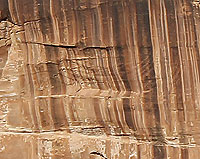 |
| Close up of multi-colored desert varnish on the White Rim Sandstone. Types of rock coatings most likely present include rock varnish, heavy metal skins, silica glaze, and black fungi. |
Most of the time when we look at the canyon scenery near Moab, it is not the color of the rock itself that we are seeing. Most of the sandstones that form the cliffs and slickrock domes found throughout southeastern Utah are light in color: off-white to tan or pink. But the darker colors of the rock surfaces are a large part of any view, whether they are the reddish-brown cliffs above Moab or the dark-brown to black streaks that paint many lighter-colored rock surfaces. Dark surface coatings are also integral to formation of petroglyphs—rock carvings made by chipping through dark surface patinas to expose lighter-colored bedrock.
These mostly red to brown to black rock surface coatings are generally known as desert varnish in southeastern Utah, but they are usually complicated mixtures of several different types of rock coatings: rock varnish, case hardening, heavy metal skins, silica glaze, and others. (Note, this article uses the term desert varnish to indicate any dark-colored rock surface coating regardless of its specific type(s).)
Desert varnish forms on most bare rock surfaces that are stable (e.g., resistant to weathering, rock decay, and erosion), sometimes preferentially forming where water flows down cliff-faces during rain storms, yielding a streaky appearance. These thin coatings are distinct from the bedrock below them, with components derived from surface water flowing over rock, windblown dust, and fungi and other microorganism living on the rock.
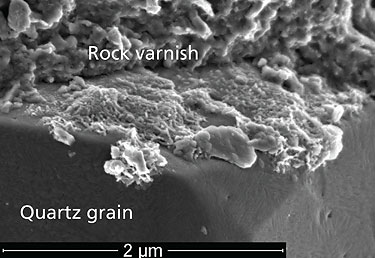 |
| Electron microscope image of rock varnish beginning to coat a quartz grain. Photo courtesy of Ron Dorn, Arizona State University. |
Rock varnish can form in any environment, but is prevalent in desert climates where bare rock surfaces are common. It predominantly consists of clay minerals with a substantial proportion of iron and manganese oxides plus minor amounts of other components. It ranges in color from red to black with higher concentrations of manganese producing varnishes that are more black in appearance. Manganese and iron oxides bind the clay minerals to the surfaces. The mechanisms that concentrate manganese oxides in rock varnish are not fully understood, but it is likely that involves physical/chemical processes as well as biological activity of some microorganisms.
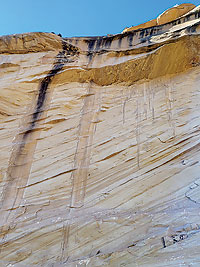 |
| Sometimes desert varnish can form within a short time period. This rock face was exposed by a large rock fall in 1997. These water streaks likely consist of black fungi, heavy metal (iron and manganese) skins, silica glaze, and perhaps incipient rock varnish. NPS photo by Clayton Middleton. |
Case hardening is the formation of a hard protective coating on rock surfaces that occurs during weathering. It results from the addition of cementing agents (iron or manganese oxides, silica, and/or other compounds) to the surface of the rock, hardening it and making it more resistant to further weathering or erosion. Surfaces that have been case hardened may be flat where they originally formed in a joint (rock fracture) and may stand out in relief relative to softer bedrock.
Heavy metal skins are coatings that consist almost exclusively of iron, manganese, and other metals (e.g., without clay minerals). Many of the black tapestries found on many cliff faces show where water flows down them during storms are heavy metal skins, but black-colored water streaks may be coatings of black fungi mixed with minerals.
Silica glaze is another type of surface coating common on sandstone surfaces. It may be light-colored, but also may be dark when iron or manganese oxides are mixed with it. Silica is readily available on sandstone surfaces, and coatings of amorphous silica and aluminum may have a shiny luster.
In all, researchers have described at least 14 different types of rock coatings, most of which may be components of the phenomena that we know as desert varnish. Desert varnish is an integral part of the canyon country landscape, sometimes protecting rock surfaces from further weathering and erosion, other times providing the canvas necessary for the creation of petroglyphs. But in itself, desert varnish tells a wide array of particular stories about its own formation and composition, and therefore, deserves to be appreciated for its own unique set of characteristics.
Special thanks to Dr. Ronald Dorn, Arizona State University.
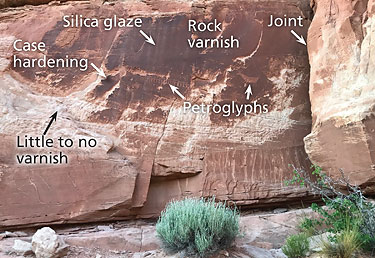 |
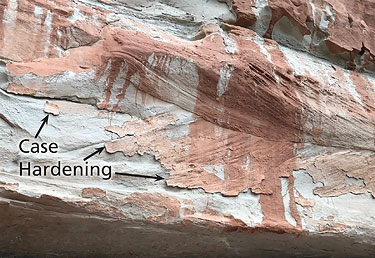 |
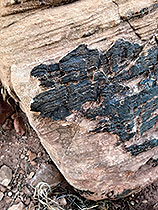 |
| Rock surface showing several types of rock coatings, including rock varnish, case hardening, and silica glaze. The silica glaze is subtle, very faint, and light in color. The rock varnish and case hardening most likely started to form on the right side of the photo. Unweathered bedrock is off-white in color. |
The red surface coating likely consists of clay minerals and iron oxides. It formed where water flows down the cliff face. Areas of case hardening are more resistant to erosion than the underlying bedrock. |
Case hardening on light-colored sandstone. |
|